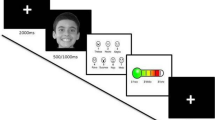Abstract
This study examined age and gender differences in decoding nonverbal cues in a school population of 606 (pre)adolescents (9–15 years). The focus was on differences in the perceived intensity of several emotions in both basic and non-basic facial expressions. Age differences were found in decoding low intensity and ambiguous faces, but not in basic expressions. Older adolescents indicated more negative meaning in these more subtle and complex facial cues. Girls attributed more anger to both basic and non-basic facial expressions and showed a general negative bias in decoding non-basic facial expressions compared to boys. Findings are interpreted in the light of the development of emotion regulation and the importance for developing relationships.



Similar content being viewed by others
Notes
ANOVA analyses showed that the perceived intensities of all the target emotions in the basic facial expressions were significantly higher than the non-target emotions and higher than the perceived intensities of the same emotion in the non-basic expressions (statistical data available from the first author). Thus, basic expressions clearly showed a dominant emotion contrary to the non-basic faces in which a more balanced mix of emotions and lower intensities were indicated.
The somewhat lower correlation for joy is due to the lack of ambiguous smiles in the DANVA pictures.
Unlike Hall and Matsumoto (2003) we could not analyze target and non-target emotions in the same analyses due to a very high number of multivariate outliers.
References
Bouhuys, A. L., Bloem, G. M., & Groothuis, T. G. G. (1995a). Induction of depressed and elated mood by music influences perception of facial emotional expressions in healthy subjects. Journal of Affective Disorders, 33, 215–226.
Bouhuys, A. L., Geerts, E., & Gordijn, M. C. M. (1999). Gender-specific mechanisms associated with outcome of depression: Perception of emotions, coping and interpersonal functioning. Psychiatry Research, 85, 247–261.
Bouhuys, A. L., Geerts, E., Mersch, P. P. A, & Jenner, J. A. (1995b). Nonverbal interpersonal sensitivity and persistence of depression: The perception of emotions in schematic faces. Psychiatry Research, 64, 193–203.
Bouhuys, A. L., Geerts, E., Mersch, P. P. A, & Jenner, J. A. (1997). Relationship between perception of facial emotions and anxiety in clinical depression: Does anxiety perception predict persistence of depression? Journal of Affective Disorders, 31, 39–48.
Boyatzis, C. J., & Satyaprasad, C. (1994). Children’s facial and gestural decoding and encoding: Relations between skills and with popularity. Journal of Nonverbal Behavior, 18, 37–55.
Brown, J. R., & Dunn, J. (1996). Continuities in emotion understanding from three to six years. Child Development, 67, 789–802.
Camras, L. A. (1985). Socialization of affect communication. In M. Lewis, & C. Saarni (Eds.), The socialization of emotions (pp. 141–160). New York: Plenum.
DePaulo, B. M. (1992). Nonverbal behavior and self-presentation. Psychological Bulletin, 111, 203–243.
Downey, G., Lebolt, A., Rincon, C., & Freitas, A. L. (1998). Rejection sensitivity and children’s interpersonal difficulties. Child Development, 69, 1074–1091.
Elfenbein, H. A., & Ambady, N. (2002). Predicting workplace outcomes from the ability to eavesdrop on feelings. Journal of Applied Psychology, 87, 963–971.
Ekman, P., Friesen, W. V., O’Sullivan, M., Diacoyanni-Tarlatzis, I., Krause, R., Pitcairn, T., Scherer, K., Chan, A., Heider, K., LeCompte, W. A., Ricci-Bitti, P. E., Tomita, M., & Tzavaras, A. (1987). Universals and cultural differences in judgments of facial expressions of emotion. Journal of Personality and Social Psychology, 53, 712–717.
Erwin, P. (1993). Friendship and peer relations in children. Chichester: Wiley.
Gnepp, J., & Hess, D. L. R. (1986). Children’s understanding of verbal and facial display rules. Developmental Psychology, 22, 103–108.
Hale, W. H., Jansen, J. H. C., Bouhuys, A. L., & van den Hoofdakker, R. H. (1998). The judgment of facial expresions by depressed patients, their partners and controls. Journal of Affective Disorders, 47, 63–70.
Hall, J. (1984). Non-verbal sex differences: Communication accuracy and expressive style. Baltimore, MD: The John Hopkins University Press.
Hall, J. A., & Matsumoto, D. (2003). Gender differences in judgments of multiple emotions from facial expressions. Emotion, 4, 201–206.
Hammen, C., & Rudolph, K. C. (1996). Childhood depression. In E. J. Mash & R. A. Barkley (Eds.), Child psychopathology (pp. 153–195). New York: Guilford.
Hartup, W. W. (1996). The company they keep: Friendships and their developmental significance. Child Development, 67, 1–13.
Hankin, B. L., Abramson, L. Y., Agell, K. E., McGee, R., Moffit, T. E., & Silva, P. A. (1998). Development of depression from preadolescence to young adulthood: Emerging differences in a 10-year longitudinal study. Journal of Abnormal Psychology, 107, 128–140.
Herba, C. M., Landau, S., Russell, T., Ecker, C., & Phillips, M. L. (2006). The development of emotion-processing in children: effects of age, emotion and intensity. Journal of Child Psychology and Psychiatry, 47, 1098–1106.
Hess, U., Adams, R. B., & Kleck, R. E. (2004). Facial appearance, gender and emotion expression. Emotion, 4, 378–388.
Hess, U., Blairy, S., & Kleck, R. E. (2000). The influence of facial emotion displays, gender and ethnicity on judgments of dominance and affiliation. Journal of Nonverbal Behavior, 24, 265–283.
Kroger, J. (2000). Identity development, adolescence through adulthood. Thousand Oaks: Sage Publications.
LaFrance, M., & Hecht, M. A. (1999). Option or obligation to smile: The effects of power and gender on facial expression. In P. Philippot, R. S. Fledman, & E. J. Coats (Eds.) The social context of nonverbal behavior (pp. 45–70). Paris: Cambridge University Press.
Lancelot, C., & Nowicki, S. (1997). The association between receptive nonverbal processing abilities and internalizing/externalizing problems in girls and boys. The Journal of Genetic Psychology, 15, 297–302.
Larsen, J. T., To, Y. M., & Fireman, G. (2007). Children’s understanding and experience of mixed emotions. Psychological Science, 18, 186–191.
MacKelvie, S. J. (1973). The meaningfulness and meaning of schematic faces. Perception and Psychofysics, 14, 343–348.
Marsh, A., Kleck, R. E., & Ambady, N. (2005). The effects of fear and anger facial expressions on approach- and avoidance-related behaviors. Emotion, 5, 119–124.
Matsumoto, D., Yoo, S. H., Hirayama, S., & Petrova, G. (2005). Development and validation of a measure of display rule knowledge: The Display Rule Assessment Inventory. Emotion, 5, 23–40.
McClure, E. B. (2000). A meta-analytic review of sex differences in facial expression processing and their development in infants, children, and adolescents. Psychological Bulletin, 126, 424–453.
Motley, M. T., & Camden, C. T. (1988). Facial expression of emotion: a comparison of posed expressions versus spontaneous expressions in an interpersonal communications setting. Western Journal of Speech Communication, 52, 1–22.
Nolan, S. A., Flynn, C., & Garber, J. (2003). Prospective relations between rejection and depression in young adolescents. Journal of Personality and Social Psychology, 85, 745–755.
Nowicki, S., & Carton, J. (1993). The measurement of emotional intensity from facial expressions. The Journal of Social Psychology, 133, 749–750.
Nowicki, S., & Duke, M. P. (1992). The association of children’s nonverbal decoding abilities with their popularity, locus of control, and academic achievement. Journal of Genetic Psychology, 153, 385–393.
Nowicki, S., & Duke, M. P. (1994). Individual differences in the nonverbal communication of affect: the diagnostic analysis of nonverbal accuracy scale. Journal of Nonverbal Behavior, 18, 9–34.
Peng, M., Johnson, C., Pollock, J., Glasspool, R., & Harris, P. (1992). Training young children to acknowledge mixed emotions. Cognition and Emotion, 6, 387–401.
Petersen, A. C., Sarigiani, P. A., & Kennedy, R. E. (1991). Adolescent depression. Why more girls? Journal of Youth and Adolescence, 20, 247–271.
Pickett, C. L., Gardner, W. L., & Knowles, M. (2004). Getting a cue: the need to belong and enhanced sensitivity to social cues. Personality and Social Psychology Bulletin, 30, 1095–1107.
Puccinelli, N. M., & Tickle-Degnen, L. (2004). Knowing too much about others: moderators of the relationship between eavesdropping and rapport in social interactions. Journal of Nonverbal Behavior, 28, 223–243.
Rosenthal, R., Hall., J., DiMatteo, M. R., Rogers, P. L., & Archer, D. (1979). Sensitivity to nonverbal communication: The PONS test. Baltimore: The John Hopkins University Press.
Rosip, J. C., & Hall, J. A. (2004). Knowledge of nonverbal cues, gender, and nonverbal decoding accuracy. Journal of Nonverbal Behavior, 28, 267–286.
Rotenberg, K. J., & Eisenberg, N. (1997). Developmental differences in the understanding of and reaction to other’s inhibition of emotional expression. Developmental Psychology, 33, 526–537.
Saarni, C. (1993). Socialization of emotion. In M. Lewis & J. M. Haviland (Eds.), Handbook of Emotions (pp. 435–446). New York: Guilford Press.
Saarni, C., & Weber, H. (1999). Emotional displays and dissemblance in childhood: Implications for self presentation. In P. Philippot, R. S. Fledman, & E. J. Coats (Eds.), The social context of nonverbal behavior (pp. 71–108). Paris: Cambridge University Press.
Segrin, C. (2000). Social skill deficits associated with depression. Clinical Psychology Review, 20, 379–403.
Underwood, M. K., Coie, J. D., & Herbsman, C. R. (1992). Display rules for anger and aggression in school-age children. Child Development, 63, 366–380.
van Beek, Y., van Dolderen, M. S. M., & Dubas, J. S. (2006). Gender-specific development of nonverbal behaviours and mild depression in adolescence. Journal of Child Psychology and Psychiatry, 47, 1272–1283.
van Beek, Y., & Dubas, J. S. (2008). Decoding basic and non-basic facial expressions and depressive symptoms in late childhood and adolescence. Journal of Nonverbal Behavior, 32. doi: 10.1007/s10919-007-0041-7.
Zeman, J., & Garber, J., (1996). Display rules for anger, sadness, and pain: It depends on who is watching. Child Development, 67, 957–973.
Zuckerman, M., Blanck, P. D., DePaulo, B. M., & Rosenthal, R. (1980). Developmental changes in decoding discrepant and nondiscrepant nonverbal cues. Developmental Psychology, 16, 220–228.
Acknowledgements
The author wishes to thank W. Kaal, D. Braspenning, G.van Renselaar, and H. van Dasler, for their help in developing the instruments and gathering the data.
Open Access
This article is distributed under the terms of the Creative Commons Attribution Noncommercial License which permits any noncommercial use, distribution, and reproduction in any medium, provided the original author(s) and source are credited.
Author information
Authors and Affiliations
Corresponding author
Rights and permissions
About this article
Cite this article
van Beek, Y., Dubas, J.S. Age and Gender Differences in Decoding Basic and Non-basic Facial Expressions in Late Childhood and Early Adolescence. J Nonverbal Behav 32, 37–52 (2008). https://doi.org/10.1007/s10919-007-0040-8
Published:
Issue Date:
DOI: https://doi.org/10.1007/s10919-007-0040-8




